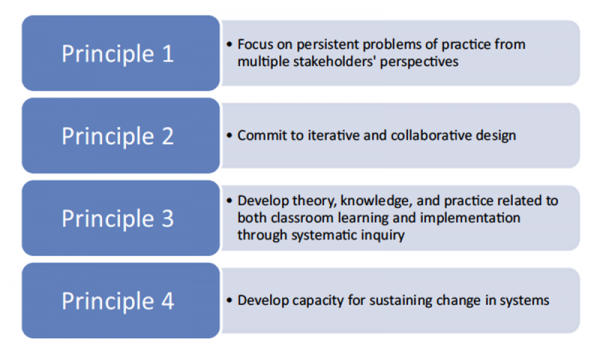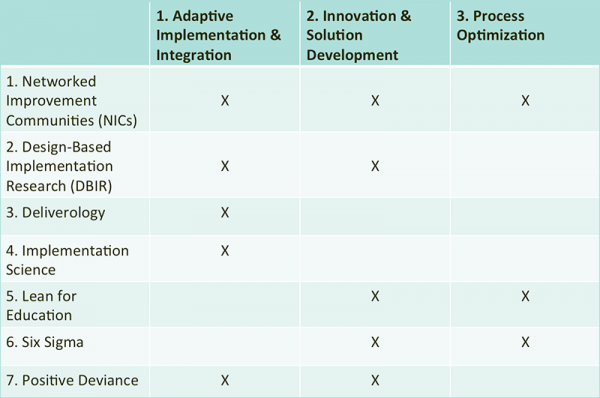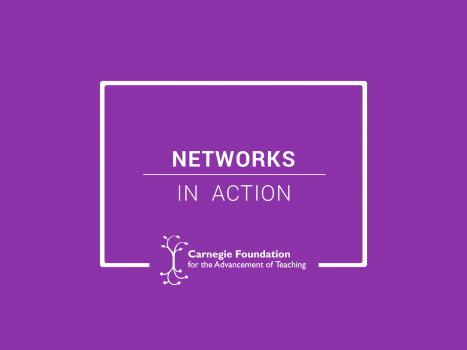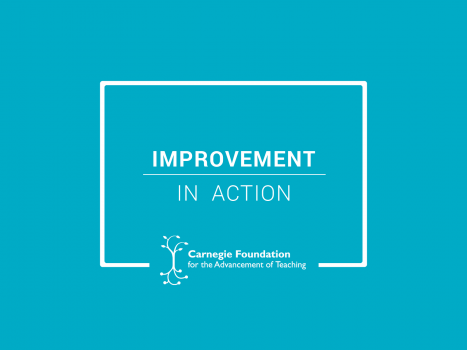Editor’s note: The current issue of Quality Assurance in Education is a special one, devoted entirely to exploring seven different improvement-based approaches to change being used in schools. Over several weeks, the Carnegie Foundation will publish blog posts summarizing each of the models, including the process, examples, and pros and cons. “Design-Based Implementation Research” is written by Paul G. LeMahieu of the Carnegie Foundation, Lee E. Nordstrum of RTI International, and Ashley Seidel Potvin with the School of Education at the University of Colorado, Boulder. We hope that these summary blog posts will whet your appetite to delve more deeply into the journal itself.
Design-based implementation research (DBIR) is an approach to improvement that emphasizes collaboration between researchers and practitioners to design interventions that can address practical problems of teaching and learning. DBIR is a relatively new model that, like the networked improvement method, draws on a long history of collaborative approaches to improvement (such as evaluation research, community-based participatory research, and design experimentation, among others). It’s most closely related to the Strategic Education Research Partnership (SERP), which was founded in 2003 to create long-term partnerships between researchers from top U.S. universities and schools seeking to improve teaching to increase student learning and achievement.
Fundamentals of the Model
Unlike some other models explored in this series, DBIR is not a detailed method with defined steps. Rather, it is a family of activities that employs collaborative and systematic inquiry, designing tools and processes to improve teaching and learning, and creating a balance between researcher and practitioner expertise.
DBIR’s theory of action is informed by four main principles: 1) Focus on persistent problems of practice from multiple stakeholders’ perspectives, 2) commit to iterative, collaborative design, 3) develop theory, knowledge, and practice related to both classroom learning and implementation through systematic inquiry, and 4) develop capacity for sustaining change in systems.
DBIR in Action: What’s the Problem?
One example of DBIR in action is STEMGenetics, a researcher-practitioner partnership that aims to improve the teaching and learning of genetics from kindergarten through twelfth grade. Under principle one, focusing on persistent problems of practice from multiple stakeholders’ perspectives, DBIR is highly focused on practical issues that stakeholders view as important — and that would, if addressed, improve teaching and learning in the topic at hand. Practitioners (teachers and education leaders) are involved in both identifying problems and developing solutions. When writing genetics curricula and assessments, the STEMGenetics partnership involves a variety of education community stakeholders, including parents, teachers, district leaders, and science education researchers.

Source: Quality Assurance in Education, Vol. 25, No. 2, 2017.
DBIR in Action: Finding, Testing, and Spreading Solutions
In many other improvement models, those who design solutions and those who implement them are two distinct groups with little overlap. But DBIR’s emphasis, as embodied in principle two, calls for a commitment to iterative and collaborative design. In STEMGenetics, stakeholders engage as equal parters in creating, carrying out, and revising interventions in each unit of study. The collaboration doesn’t stop there. The DBIR model values an even broader diversity of expertise which STEMGenetics achieves by including not only teachers and researchers, but also experts in curriculum design, software design, graphic design, and science content and instruction.
The model does not provide a specific protocol for testing and refining solutions, instead, the work of DBIR partnerships adheres to the four guiding principles described earlier. When measuring the effects of interventions, DBIR partnerships often consider multiple types of evidence. These may include running controlled experiments, however, they are not generally viewed as necessary. The STEMGenetics team, for example, used classroom observation techniques to check for increases in student understanding, they analyzed student assessments, and solicited formal feedback from teachers implementing the curricula to iteratively refine the units of study.
When DBIR partnerships see variation in the data they collect, their focus turns to the third principle: developing theory and knowledge of both classroom learning and implementation through systematic inquiry. (The very name of the model indicates how important it is to get implementation right.) When something works in one setting, but not in another, DBIR partners will examine how specific elements in each of the different classrooms, schools, or districts affects the implementation. They will study implementation systematically and revise components based on what they learn. The DBIR approach sees the learning context as having a significant influence on whether or not an intervention is successful, therefore, understanding that context (the school culture, the capabilities of system actors, overarching policies, etc.) is key.

At its core, DBIR is about bringing research-based innovations to scale. So, while DBIR interventions usually start out as specific to one classroom, school, or district, teams often end up testing them across contexts. The fourth principle — develop capacity for sustaining change in systems — describes how DBIR partnerships work to spread the knowledge that they develop. Creating the capacity for sustained change often requires breaking down silos within and between organizations, so DBIR partnerships must be able to support all stakeholders in carrying out the design, testing, and implementation of solutions.
One element of capacity-building entails improving social capital. This is achieved by ensuring that all stakeholders have access to the same resources and experts. Additionally, in order to implement the changes in a coordinated manner, everyone involved needs to know certain information about a school or district, such as their process for professional development to improve teaching and learning. The STEMGenetics team built capacity and social capital by utilizing mentor teachers who were able to provide immediate, on-the-ground support to their peers during implementation.
Although it’s a relative newcomer to improvement methodology, DBIR has resulted in strong researcher-practitioner partnerships in the districts where it’s being implemented. Its approach of bringing in districts and researchers from the start of the process also creates a deep commitment among these groups to do what’s necessary to succeed, which is essential when problems arise that require a quick solution. As it matures, however, DBIR will have to resolve some questions and challenges. For example, it will need to establish clear roles and authority in the partnerships to reduce the potential for conflicts, and it needs to reach beyond district leadership and include stakeholders at all levels in order to generate broad support for the improvement work and to ensure continuity when people leave.
Recently, as DBIR has become more widely used, LearnDBIR and the Research-Practice Collaboratory have been creating shared tools and practices. Additionally, a network is developing around the DBIR model with an annual workshop for people interested in engaging in research using this approach and sharing their work across a wider variety of contexts.
Sarah McKay is a former associate for research and communications at the Carnegie Foundation.
March 3, 2017
Social relationships are key to the potential of networked improvement communities to accelerate and sharpen education change using the improvement science approach. Veterans of the process explain how they keep strengthening those connections while expanding their networks.
March 9, 2017
A school performance framework in California’s Oakland Unified School District gives schools a multi-faceted and detailed look at where they need to improve based on more than a dozen measures of both academic achievement and the culture and climate of the school.







